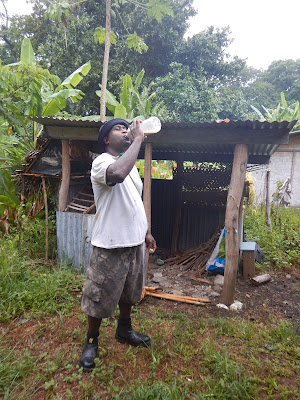 |
| that baby powder glow |
 |
| smiles! |
 |
| first born and papa |
Here’s what that looks like:
• Building the fire to heat the stone to make the earth oven
• Grading the taro, manioc, green banana, yam, and/or kumala
• Collecting the “laplap leaves” and wrapping the mush for baking
• Removing the hot hot stones, placing the bundle in the pit, and covering it back up with the stones again. You use a big branch that’s split ¾ of the way down as bigfala tongs.
• Meanwhile, dehusking, cracking open, and grading the coconuts
• Milking the shredded meat and boiling it into cream.
• Once the laplap is finished cooking (I think a sixth sense notifies everyone here that it’s ready) you remove the stones and the laplap bundle, open her up, and dribble coconut cream all over it
• A note on this! I’ve never seen anyone pour the cream on the laplap and smear it around. This would be much more efficient. Instead they take a spoon and drizzle it on randomly until it covers the whole thing. I’ve asked a few women why the do this and they looked at me like I was crazy. It’s just what they do!
I sat down with my bumbu Joyce and cousin Kendra and helped with the coconut grading. Other than the 3 laplaps being made on the school grounds, many more were in the works in individual kitchens around the community. My papa and uncle went and killed one of my brother’s mama pigs because she’s got a terrible habit of eating baby chicks. I learned that this Wala (all of the pigs are named Wala) is the mama of so many other Walas I know. Strike three, Wala, sorry. They shot her in the bush and then two men carried her down on a bamboo pole. They butchered the pig and put it (her?) in an earth oven to bake. I didn’t grow up eating pig, so I never had a taste for it before here. But let me tell ya, fresh, well-fed, baked or roasted pig is a delicious treat.
After lunch time our laplap was ready. Almost like clockwork, a slew of women with laplaps and mats balanced on their heads enter the school. The ceremony began mid-afternoon. Because it was a rainy Saturday, we were inside the assembly hall. My papa used the world map to explain his China travels and everyone ooo’d and ahhh’d thinking about the foreign land. Mats were given to my papa and then he gave some to the auntie that presented him. Lots of mat exchange in these parts! My uncle John Richard got back from Australia recently, too, where he manages Ni-Vanuatu groups of fruit pickers. His brother died from a heart attack while doing the same this in New Zealand, so my uncle came back to grieve with his family. They presented him with mats, too. We all drank kava and feasted on the good food in front of us. Welcome back Papa!
 |
| kendra and bubu joyce on laplap duty |
 |
| backyard kava pulls |
 |
| explaining his china adventure |
There are many traditional ways to prepare kava and these vary from island to island. Preparing kava just refers to the process of transforming it from intact root crop into mush so it can be sieved with water for drinking. For example, on Tanna and Aneityum, they chew the kava. In some areas of Tanna this is done my virgin boys only! On some islands they ram it into a stone and on Ambae they grind it into a long wooden bowl with a wooden pestle. It’s called qasis (pronounced kwa-sees) and only a few men still have the tools needed to make it this way. Nowadays everyone primarily uses mincers to mushify their kava. These hand grinders are all over the place on every island! One time I made the mistake of asking if I could use one to make peanut butter. It was a definite no.
The traditional preparation methods result in a much more potent shell of kava. On Chief’s Day, my cousin Hickman brought down a stumpa of kava from his garden and Uncle John Richard agreed to grind it for me. I drank two shells with my brother and mama, and the rest was brought over to the mincer for easy prep. I had a few more shells of that and slept soundly in my kava-induced slumber.
 |
| qasis! |
 |
| sweet nectarine |






It's very good of you alison to have integrated into a family of lolovenue area in vanuatu! You are being adopted and anytime in the future you or your close family want to visit ambae then you have a base already there! Well done!
ReplyDelete